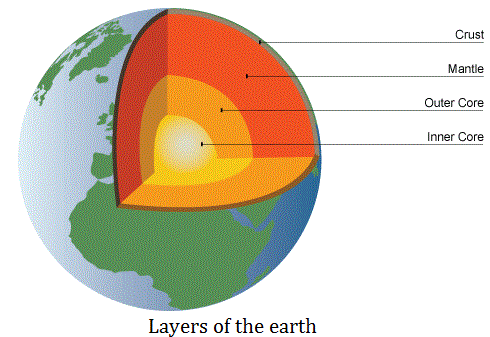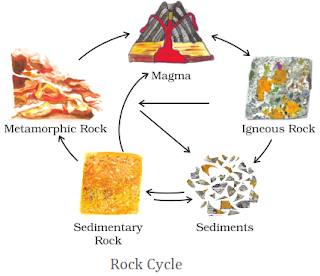Study Material and Notes of Ch 2 Inside Our Earth Class 7th Geography
Topics in the Chapter
• Planet Earth
• Interior of the Earth
• Interior of the Earth
→ Crust
→ Mantle
→ Core
• Rocks and their Types
→ Igneous rocks
→ Sedimentary rocks
→ Metamorphic rocks
→ Igneous rocks
→ Sedimentary rocks
→ Metamorphic rocks
• Use of Rocks
• Rock Cycle
• Minerals
Planet Earth
• The earth in which humans live is not absolute spherical in shape.
Interior of earth
• The earth is like onion which is made up of several layers.

Crust
• The uppermost layer over the earth’s surface is called the crust.
• It is the thinnest of all the layers.
→ It is 35 km thick on the landmass (continental masses) and only 5 km on the ocean floors.
→ Thus, it is called sial (si-silica and al-alumina).
• The oceanic crust mainly consists of silica and magnesium
→ Thus, it is called sima (si-silica and ma-magnesium).
• This layer extends up to a depth of 2900 km below the crust.
Core
• The innermost layer is the core.
• The radius of core is about 3500 km.
• It is mainly made up of nickel and iron.
→Thus, it is called nife (ni – nickel and fe – ferrous i.e. iron).
• The central core has very high temperature and pressure.
Rocks
• Any natural mass of mineral matter that makes up the earth’s crust is called a rock.
• It can be of different colour, size and texture.
• There are three major types of rocks:
→ Igneous rocks
→ Sedimentary rocks
→ Metamorphic rocks
Igneous Rocks
• When the molten magma cools, it becomes solid and are called igneous rocks.
• They are also called primary rocks.
• There are two types of igneous rocks:
→ Intrusive rocks
→ Extrusive rocks
• When the molten lava comes on the earth’s surface, it rapidly cools down and becomes solid on the crust. These rocks are called extrusive igneous rocks.
→ They have a very fine grained structure.
→ Example: Basalt. The Deccan plateau is made up of basalt rocks.
• When the molten magma cools down deep inside the earth’s crust giving formation of solid rocks are called intrusive igneous rocks.
→ Since they cool down slowly they form large grains.
→ Example: Granite. Grinding stones used to prepare paste/powder of spices and grains are made of granite.
Sedimentary Rocks
• Rocks roll down, crack, and hit each other and are broken down into small fragments which are called sediments.
• These sediments are transported and deposited by wind, water, etc. These loose sediments are compressed and hardened to form layers of rocks. These types of rocks are called sedimentary rocks. → Example: Sandstone is made from grains of sand.
• Sedimentary rocks may also contain fossils of plants, animals and other micro-organisms that once lived on them.
Metamorphic Rocks
• Under great heat and pressure, Igneous and sedimentary rocks can change into metamorphic rocks.
→ Example: clay changes into slate and limestone into marble.
Use of Rocks
• Rocks are used for construction activities such as making buildings, roads.
• They are source of minerals which are useful for various purposes in daily life.
Rock Cycle
• The process of transformation of the rock from one to another is known as the rock cycle.
• It describes the changes among the three main type of rock i.e., Igneous, Sedimentary and Metamorphic rocks.

→ When the molten magma cools; it solidifies to become igneous rock.
→ These igneous rocks are broken down into small particles by various agents such as weathering, temperature, wind etc. and are transported and deposited to form sedimentary rocks.
→ These smaller grains of rocks keep moving towards basins and lower regions and gradually form sedimentary rocks.
→ When the igneous and sedimentary rocks are subjected to heat and pressure they change into metamorphic rocks.
→ The metamorphic rocks which are still under great heat and pressure melt down to form molten magma.
→ This molten magma again can cool down and solidify into igneous rocks.
Note: These processes take hundreds and thousands of years.
Minerals
• Minerals are naturally occurring substances which have certain physical properties and definite chemical composition.
• These are very important for humans.
• For example, coal, natural gas and petroleum. They are also used in industries – iron, aluminium, gold, uranium, etc, in medicine, in fertilisers, etc.

